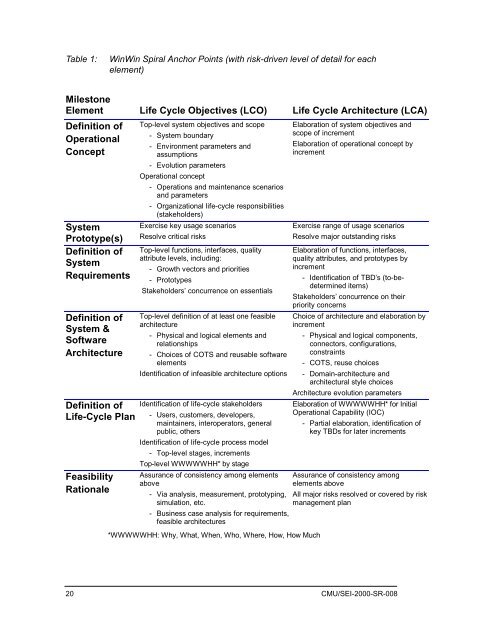00sr008
00sr008
00sr008
You also want an ePaper? Increase the reach of your titles
YUMPU automatically turns print PDFs into web optimized ePapers that Google loves.
Table 1:<br />
WinWin Spiral Anchor Points (with risk-driven level of detail for each<br />
element)<br />
Milestone<br />
Element Life Cycle Objectives (LCO) Life Cycle Architecture (LCA)<br />
Definition of<br />
Operational<br />
Concept<br />
System<br />
Prototype(s)<br />
Definition of<br />
System<br />
Requirements<br />
Definition of<br />
System &<br />
Software<br />
Architecture<br />
Definition of<br />
Life-Cycle Plan<br />
Feasibility<br />
Rationale<br />
Top-level system objectives and scope<br />
- System boundary<br />
- Environment parameters and<br />
assumptions<br />
- Evolution parameters<br />
Operational concept<br />
- Operations and maintenance scenarios<br />
and parameters<br />
- Organizational life-cycle responsibilities<br />
(stakeholders)<br />
Exercise key usage scenarios<br />
Resolve critical risks<br />
Top-level functions, interfaces, quality<br />
attribute levels, including:<br />
- Growth vectors and priorities<br />
- Prototypes<br />
Stakeholders’concurrence on essentials<br />
Top-level definition of at least one feasible<br />
architecture<br />
- Physical and logical elements and<br />
relationships<br />
- Choices of COTS and reusable software<br />
elements<br />
Identification of infeasible architecture options<br />
Identification of life-cycle stakeholders<br />
- Users, customers, developers,<br />
maintainers, interoperators, general<br />
public, others<br />
Identification of life-cycle process model<br />
- Top-level stages, increments<br />
Top-level WWWWWHH* by stage<br />
Assurance of consistency among elements<br />
above<br />
- Via analysis, measurement, prototyping,<br />
simulation, etc.<br />
- Business case analysis for requirements,<br />
feasible architectures<br />
*WWWWWHH: Why, What, When, Who, Where, How, How Much<br />
Elaboration of system objectives and<br />
scope of increment<br />
Elaboration of operational concept by<br />
increment<br />
Exercise range of usage scenarios<br />
Resolve major outstanding risks<br />
Elaboration of functions, interfaces,<br />
quality attributes, and prototypes by<br />
increment<br />
- Identification of TBD’s (to-bedetermined<br />
items)<br />
Stakeholders’concurrence on their<br />
priority concerns<br />
Choice of architecture and elaboration by<br />
increment<br />
- Physical and logical components,<br />
connectors, configurations,<br />
constraints<br />
- COTS, reuse choices<br />
- Domain-architecture and<br />
architectural style choices<br />
Architecture evolution parameters<br />
Elaboration of WWWWWHH* for Initial<br />
Operational Capability (IOC)<br />
- Partial elaboration, identification of<br />
key TBDs for later increments<br />
Assurance of consistency among<br />
elements above<br />
All major risks resolved or covered by risk<br />
management plan<br />
20 CMU/SEI-2000-SR-008














